Photographing Ducks
by Dr. Leonard Lee Rue III
 You
have to have water if you are going to have ducks. Now that's such an
obvious statement that it sounds ridiculous to make it, but you would be
surprised to learn what a hard job it was for biologists and
conservationists to get that basic fact across to the general public and
to the federal government just seventy years ago. You
have to have water if you are going to have ducks. Now that's such an
obvious statement that it sounds ridiculous to make it, but you would be
surprised to learn what a hard job it was for biologists and
conservationists to get that basic fact across to the general public and
to the federal government just seventy years ago.
And it's a job that's still a hard sell today, even when we know all
the facts. Not only do the ducks need water; they need clean water. Even
today there are departments of the United States government that are
destroying what other departments in the government are trying to create,
or are destroying what the others are trying to save. Sometimes both
departments work out of the very same office and some of the opposing
individuals even have their desks across from each other.
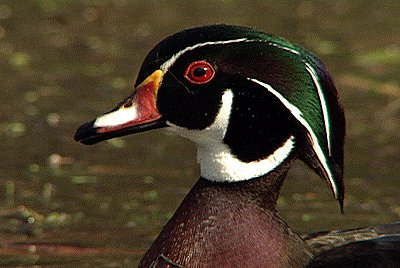 All
through the first half of the twentieth century engineers, working for the
Department of Agriculture, drained millions of acres of marshland and
potholes to put the land into agricultural production. That land on the
Great Plains, extending from Nebraska up through the Dakotas and into
Manitoba and Saskatchewan in Canada, was the main duck factory in North
America. Draining went on in all other parts of the nation and it's still
going on in places today. We are losing 100,000 wetland acres each year.
However, nothing approached the conversion of wetlands to dry lands that
took place on the prairies. All
through the first half of the twentieth century engineers, working for the
Department of Agriculture, drained millions of acres of marshland and
potholes to put the land into agricultural production. That land on the
Great Plains, extending from Nebraska up through the Dakotas and into
Manitoba and Saskatchewan in Canada, was the main duck factory in North
America. Draining went on in all other parts of the nation and it's still
going on in places today. We are losing 100,000 wetland acres each year.
However, nothing approached the conversion of wetlands to dry lands that
took place on the prairies.
To make matters worse, the long lasting droughts of the "dust
bowl" years in the early 1930s eliminated most of the water remaining
on the prairies and decimated the duck populations. I grew up on a farm in
northwestern New Jersey, an area not noted for ducks in the first place,
and I never saw a duck until about 1942.
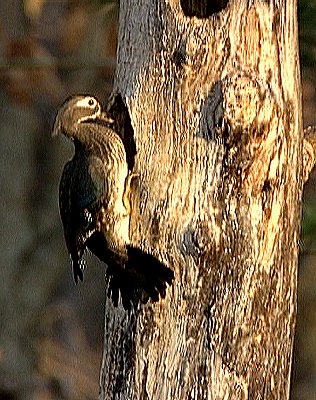 Fortunately,
thankfully, such ardent conservationists as "Ding" Darling,
South Dakota Senator Norbeck, Aldo Leopold, and others, made the public
aware of the duck's plight and got the duck stamp program going to raise
funds to purchase land to enlarge the national refuge program started by
President Theodore Roosevelt. Fortunately,
thankfully, such ardent conservationists as "Ding" Darling,
South Dakota Senator Norbeck, Aldo Leopold, and others, made the public
aware of the duck's plight and got the duck stamp program going to raise
funds to purchase land to enlarge the national refuge program started by
President Theodore Roosevelt.
Ducks Unlimited has raised
millions of dollars through private donations to greatly expand the
conservation plans. Private individuals, such as Dr. Donald Carter of
Butler, NJ, raised and released thousands of wood ducks. The wood duck,
the most beautiful duck in North America, was once an endangered species.
It is now quite common over most of its former range. The ducks still need
all the help they can get but, on the whole, they are common enough over
most of the United States that everyone can photograph some of the species
at some time throughout the year.
What do you need to photograph ducks? The longest telephoto lens you
can possible afford. Ducks are hunted over most of the country and parts
of most wildlife refuges are also open to hunting, although no hunting is
allowed in our national parks. As ducks are migratory species, almost
every duck is exposed to hunting pressure at certain times of the year in
most locations and that makes them exceptionally wary. Mother ducks don't
raise dummies; ducks that have been shot at don't come close, so you need
a long lens.
 That
brings us up to the next most important item of need, or perhaps it is the
most important. I've just stressed how wary ducks are, so it should be
instantly apparent that, if the ducks can see you, you will not be able to
see the ducks, at least not through a viewfinder. Except in city parks,
ducks must be photographed from a blind. According to where I am, and the
situation, I use either the Rue
Pocket or Ultimate Blind. On private land, where the blind won't
be stolen, it's best to put your Rue Ultimate Blind up for several days
before you intend to use it so that the ducks become accustomed to it. On
a number of refuges, the government has put up permanent blinds for use by
the public and, of course, that works best of all because, as they are
always there, the ducks accept them as an integral part of the landscape. That
brings us up to the next most important item of need, or perhaps it is the
most important. I've just stressed how wary ducks are, so it should be
instantly apparent that, if the ducks can see you, you will not be able to
see the ducks, at least not through a viewfinder. Except in city parks,
ducks must be photographed from a blind. According to where I am, and the
situation, I use either the Rue
Pocket or Ultimate Blind. On private land, where the blind won't
be stolen, it's best to put your Rue Ultimate Blind up for several days
before you intend to use it so that the ducks become accustomed to it. On
a number of refuges, the government has put up permanent blinds for use by
the public and, of course, that works best of all because, as they are
always there, the ducks accept them as an integral part of the landscape.
I created my own private refuge, in 1970, by dredging a ¾ acre pond on
my land. I have built a permanent blind that provides as close to a
guarantee for duck photography as is possible. I have always advocated
using bait to photograph every species that can be baited, where it is
legal. Let me stress that last point again. DO NOT BAIT ducks on
either public or private land where hunting is allowed because there are
strict federal laws against baiting under those circumstances. No duck
hunting is allowed on my refuge, ever. Even if you don't hunt, if someone
else should hunt over a pond you had baited, even if they did not know you
had baited, they could face stiff penalties if discovered.
I use shelled corn for bait as the ducks love it and thrive on it, and
it only costs about nine dollars per hundred pounds. I feed several tons a
year as I put a pail full of corn in my pond every day that the pond is
not frozen over and, if the ducks are still coming in, I throw the corn
out on the ice. I just love to see the ducks flying in and swimming
about.
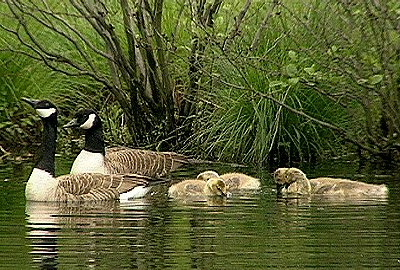 Because
I have been putting food out for the ducks for over thirty years, my pond
is a Mecca for them, although I don't know where they go when they leave
my pond. I have had as many as seventy-six wood ducks at one time,
although I usually average no more than three dozen. I have had over one
hundred twenty-five mallards at one time and usually a dozen Canada geese.
I would probably have more geese, but the pair that nests on the pond each
spring and summer chase most of the others off. I get a few black ducks
with the mallards and, occasionally, a few ring-necked ducks. The corn
also attracts muskrats and deer to the pond. Painted turtles crawl up on
the logs I put out for the ducks and, once in a while, herons come in to
try for the fish. Because
I have been putting food out for the ducks for over thirty years, my pond
is a Mecca for them, although I don't know where they go when they leave
my pond. I have had as many as seventy-six wood ducks at one time,
although I usually average no more than three dozen. I have had over one
hundred twenty-five mallards at one time and usually a dozen Canada geese.
I would probably have more geese, but the pair that nests on the pond each
spring and summer chase most of the others off. I get a few black ducks
with the mallards and, occasionally, a few ring-necked ducks. The corn
also attracts muskrats and deer to the pond. Painted turtles crawl up on
the logs I put out for the ducks and, once in a while, herons come in to
try for the fish.
I have always said that, when working from a blind, be alert to every
photographic opportunity. Don't be single-minded. While waiting for ducks,
I've gotten great gray squirrel, hawk, crow, kingfisher and song bird
photos.
Wood ducks, as their name implies, live primarily in heavily wooded
areas. They, and the buffleheads, goldeneyes and mergansers, are some of
the few ducks that nest in tree hollows.
As these hollows are always in short supply, wood duck nesting boxes
have been built and put up by the tens of thousands by people and
organizations interested in increasing this duck's population.
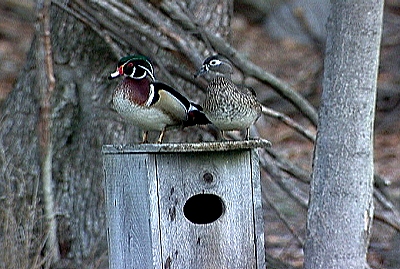 I
have put up nine boxes and usually have four or five boxes used every
year. Put up some of these nesting boxes on ponds in your own area and
they will give you many photographic opportunities. If you build them,
they will come. You can get excellent plans and information from Ducks
Unlimited on line at www.ducks.org.
or by calling 901-758-3764. You should join Ducks Unlimited as they, like
the ducks, also need all the help they can get. They are a key player in
increasing duck numbers throughout North America. I
have put up nine boxes and usually have four or five boxes used every
year. Put up some of these nesting boxes on ponds in your own area and
they will give you many photographic opportunities. If you build them,
they will come. You can get excellent plans and information from Ducks
Unlimited on line at www.ducks.org.
or by calling 901-758-3764. You should join Ducks Unlimited as they, like
the ducks, also need all the help they can get. They are a key player in
increasing duck numbers throughout North America.
The ducks are most active just at dawn and from late afternoon until
dark. That means, if it's light enough for you to see the ducks at 6:00 a.
m., you will have to be in your blind by 5:00 a. m. because the ducks will
start dropping in at 5:30 or before it's light enough for you to see them.
You will know they are coming in by their whistling wings and the splashes
they make as they set down. If you are late getting into your blind in the
morning and you flush the ducks off, they probably won't come back until
the afternoon. Because you may be shooting under less than optimal
conditions, you may have to push your Fuji Sensia 100 or Kodak Elite
Chrome 100 to an ISO of 200. With digital cameras, you can just dial in a
higher ISO of 250 or even 800.
 |
| When working
from a blind, be alert to every photographic opportunity
Don't be single-minded. While
waiting for ducks, I've gotten great gray squirrel, hawk,
crow, kingfisher and song bird photos.
Corn put out for ducks attracts
muskrats and deer and don't forget other pond residents such
as these painted turtles. |
|
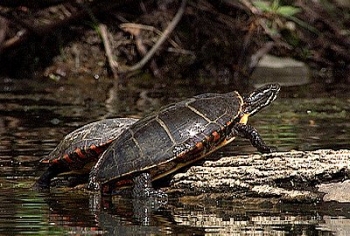 |
Some Duck Facts You Should Know:
While mallard ducks remain in the north in any area where they can
find open water, wood ducks usually leave my home area in October and
don't come north again until March. I've taken great wood duck photos in
the snow.
Male ducks do not help to raise their young, leaving the female when
she begins to incubate the eggs.
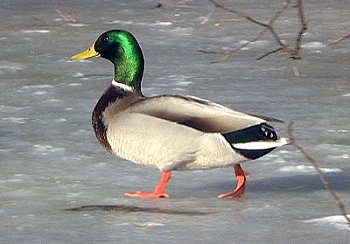 All
young ducks, male and female, wear female plumage until they molt in early
fall. Also, all ducks lose their primary flight feathers in July and
cannot fly. The males lose their bright colors at this time, wearing their
"eclipse" plumage that makes them look like females. They will
be back in full color by September. All
young ducks, male and female, wear female plumage until they molt in early
fall. Also, all ducks lose their primary flight feathers in July and
cannot fly. The males lose their bright colors at this time, wearing their
"eclipse" plumage that makes them look like females. They will
be back in full color by September.
Ducks land and take off into the wind because it is easier for them to
do so as they get additional braking power or lift from the wind.
When you see a flock of swimming ducks suddenly all turn into the wind,
get ready to take your flight shots as they take off. They often signal
that they are about to fly by elevating their heads. The higher a ducks
stretches its neck, the more anxious it is about something it perceives to
be danger.
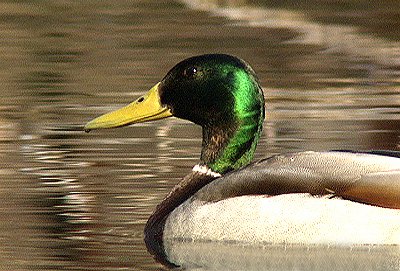 Both
the mallard and wood ducks are classified as "dipper" or pond
ducks because they usually feed in water about twelve inches deep. By
merely tipping up, they can reach food on the pond's bottom. However, both
of these ducks can, and do, feed in much deeper water by diving completely
below the surface. Both
the mallard and wood ducks are classified as "dipper" or pond
ducks because they usually feed in water about twelve inches deep. By
merely tipping up, they can reach food on the pond's bottom. However, both
of these ducks can, and do, feed in much deeper water by diving completely
below the surface.
Both of these ducks can fly by springing directly into the air. They do
not have to run along the surface of the water to get up speed, as do the
scaup, canvasback and other diving ducks.
There are now 520 national wildlife refuges in the United States, which
means that there are bound to be several of them within driving distance,
no matter where you live. Ducks can be found in almost all of them.
For those who might be interested, I am going to open my private
refuge, on a very limited basis, for photography on a "pay per
shoot" basis. If you are interested, you can get
details from my website or by calling 908-362-6616.
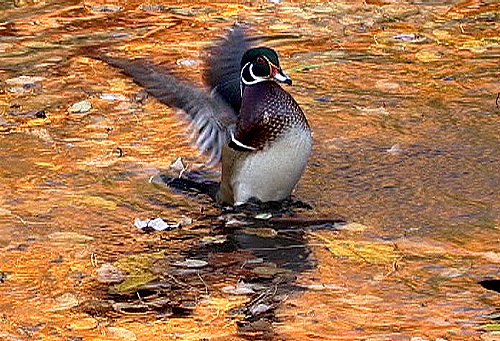
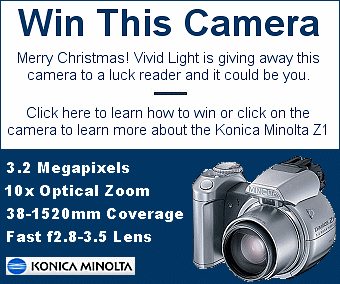
| Upcoming
Seminars with Lennie Rue
White Tailed Deer Seminar
Dr. Leonard Lee Rue III will be conducting a White-tailed deer
seminar on November 15th from 7 p.m. to 9:30 p.m. The seminar will
benefit anyone who is interested in hunting, photography or has a
general interest in the habits of the White- tailed deer. This is
a program that is geared for the entire family to enjoy. The cost
is $15 per person.
Wildlife Photography Seminar
A day long wildlife photography seminar on Saturday November
22nd from 9 a.m. to 5 p.m. Participants will learn the basics of
photography as well as tips on photographing close-ups of flowers,
insects, reptiles and amphibians, birds and a variety of mammals.
The cost is $75 per person and includes lunch. Overnight
accommodations on Friday Nov. 21st are available for $95.00 per
person and include the cost of the seminar as well as breakfast
and lunch on Saturday.
Both seminars are being hosted by The Pocono Environmental
Education Center in Dingmans Ferry Pennsylvania. Space is
limited, please call 570-828-2319 to register or obtain more
information. For more information on PEEC check out their website
at www.peec.org |
 Subscribe to
Vivid Light
Subscribe to
Vivid Light
Photography by email
Tell
Us What You Think
|


|
